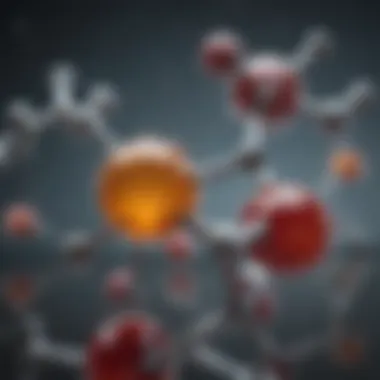Exploring Dimethyl Sulfoxide as a Cryogenic Medium


Intro
Dimethyl Sulfoxide, abbreviated as DMSO, is rapidly gaining recognition as an effective freezing medium in various scientific disciplines. This compound's unique properties allow it to function effectively in cryopreservation, a critical technique in biological and chemical research. Its versatility not only facilitates the preservation of cells and tissues but also enhances the stability of various compounds at low temperatures.
As we explore the role of DMSO in freezing applications, it is vital to focus on how its molecular structure contributes to its behavior. The solubility characteristics and low toxicity levels of DMSO have led to its extensive use in laboratories across the world.
Research Overview
Summary of Key Findings
Research highlights several key advantages of Dimethyl Sulfoxide. DMSO acts as a cryoprotectant, reducing ice crystal formation, which is often detrimental to biological samples during freezing. Studies reveal that when cells are mixed with DMSO prior to freezing, their viability post-thaw significantly increases. These findings underline DMSO's critical role in biobanking and regenerative medicine.
Background and Context
The utilization of DMSO in a freezing context has evolved since its discovery. Initially used as an industrial solvent, its applications in preserving biological materials emerged as researchers sought reliable methods for long-term storage. The increasing need for effective cryopreservation techniques in fields like stem cell research and tissue engineering has further solidified DMSO’s importance.
Methodology
Experimental Design
In experimental studies involving DMSO, researchers often employ a systematic approach to understand its impact on biological specimens. Sample groups treat samples with varying concentrations of DMSO before subjecting them to controlled freezing conditions. This structured design allows for accurate comparisons of cell viability and integrity across different treatments.
Data Collection Techniques
Data collection typically involves assessing cell viability post-thaw. Methods such as flow cytometry and live-dead staining are frequently used, enabling researchers to quantitatively measure the effectiveness of DMSO as a freezing medium. This rigorous approach ensures that the conclusions drawn from the experiments are robust and reliable.
"DMSO’s role in cryopreservation is not just beneficial; it is transformative for biological science, paving the way for advancements in regenerative medicine and biotechnology."
As the need for sustainable and effective preservation methods grows, understanding the implications of DMSO in freezing mediums continues to be a vital area of research, guiding future innovations in the field.
Prelude to Dimethyl Sulfoxide
Dimethyl Sulfoxide, often abbreviated as DMSO, is an important solvent and chemical compound widely used in various scientific and medical applications. Understanding its properties and history is essential for grasping its role in cryopreservation. The unique characteristics of DMSO allow it to protect biological structures at very low temperatures, making it a valuable resource in both research and clinical settings.
In this article, we aim to elucidate the relevance of DMSO as a freezing medium. The following sections will detail its chemical properties, historical significance, and contributions to advancements in cryopreservation techniques. DMSO's ability to permeate cell membranes without causing significant damage is a key advantage that warrants further discussion.
Chemical Properties of DMSO
DMSO is a colorless liquid with a distinctive odor and a high polarity. Its molecular formula is C₂H₆OS, indicating the presence of sulfur in its structure, which contributes to its unique properties. This compound has a high boiling point of 189 °C and is miscible with water, which enhances its utility in biological settings. DMSO exhibits strong solvent capabilities, making it effective for dissolving both polar and nonpolar compounds.
One noteworthy feature of DMSO is its ability to lower the freezing point of solutions, which is central to its application as a freezing medium. Moreover, the compound has been shown to stabilize proteins and nucleic acids during the freezing process, preventing denaturation or degradation.
Historical Background
The discovery of DMSO dates back to the 19th century when it was first synthesized as a byproduct of wood pulp processing. Its unique properties began attracting scientific attention in the mid-20th century, particularly for its potential as a cryoprotectant. In the 1960s, researchers began to investigate DMSO's role in cryobiology, paving the way for its adoption in cell preservation. The subsequent years saw an increase in applications in the medical field, especially in areas like organ transplantation and the preservation of various biological samples.
Today, DMSO is recognized not only for its freezing capabilities but also for its potential therapeutic properties, including anti-inflammatory effects. Its historical significance and chemical properties combine to make DMSO a critical component in modern cryopreservation and other scientific research.
The Science of Freezing Media


The study of freezing media is essential in both biological and chemical contexts. This knowledge guides various applications, from preserving cells and tissues to formulating products in pharmaceutical development. Understanding the properties and mechanisms at play during freezing helps researchers make informed decisions on how to best protect biological samples and enhance experimental outcomes.
Importance of Freezing in Scientific Research
Freezing serves a critical role in scientific research. It enables long-term storage of biological specimens without significant loss of integrity. For instance, researchers can freeze cells, tissues, or even entire organisms to maintain their viability for future studies. This practice is crucial for several reasons:
- Preservation: Freezing prevents degradation and maintains the functionality of cells. Without it, many valuable specimens would perish, complicating scientific inquiries.
- Transport: Freezing facilitates the transport of biological materials over long distances. This is particularly beneficial in collaborative research efforts, where samples need to travel to different laboratories.
- Consistency: Using freezing ensures uniform conditions for samples, which is vital for replicable results in experiments.
In many areas of life sciences, freezing protocols must be optimized for specific substances, considering their unique responses to low temperatures. This highlights the need for rigorous standards in freezing methods, which enhances the reliability of scientific results.
Freezing Mechanisms in Biological Samples
Understanding how freezing affects biological samples requires knowledge of the mechanisms that occur during the process. When a biological sample is frozen, the formation of ice crystals can become problematic. Ice crystals can puncture and disrupt cellular structures, leading to loss of function. Here are key points regarding the freezing mechanisms:
- Ice Formation: Initially, water freezes and forms ice crystals. The size and formation rate of these crystals can vary greatly depending on the freezing rate and composition of the solution.
- Concentration Effects: As ice forms, the remaining solution becomes more concentrated. This concentration can lead to osmotic imbalances which can harm cells. Understanding solute effects, such as those of DMSO, is vital in preventing this damage.
- Controlled Rate of Freezing: Controlled rate freezing is critical for minimizing damage. This technique gradually lowers temperatures to mitigate the effects of large ice crystal formation.
Effective preservation during freezing relies on the interplay of cellular responses and the nature of the freezing medium.
DMSO as a Freezing Medium
Dimethyl Sulfoxide (DMSO) is increasingly recognized in the scientific community for its role as a freezing medium. Its unique properties make it particularly valuable in various applications ranging from cellular research to pharmaceutical development. The discussion below elucidates the multifaceted nature of DMSO, specifically as it pertains to its cryoprotective techniques and its mechanism of action.
Cryoprotective Properties
DMSO exhibits several cryoprotective properties that are crucial for preserving biological specimens during freezing. Firstly, DMSO can effectively lower the freezing point of water, which helps to prevent ice crystal formation within cells. Ice crystals can cause physical damage to cell structures, ultimately leading to cell death or impaired function.
Another vital aspect of DMSO is its ability to permeate cell membranes. This feature encourages the penetration of the medium into the cells, ensuring consistent exposure during the cryopreservation process.
Some key benefits of DMSO's cryoprotective properties include:
- Reduced ice formation: DMSO minimizes the likelihood of ice crystals damaging cellular integrity.
- Enhanced cell viability: By protecting cells during freezing, DMSO contributes to higher cell recovery rates post-thawing.
- Compatibility with various cell types: DMSO can be utilized across diverse cellular systems, from mammalian cells to plant tissues.
Overall, the cryoprotective nature of DMSO establishes it as an essential tool for biologists and researchers aiming for successful preservation protocols.
Mechanism of Action
The mechanism through which DMSO exerts its protective effects during freezing involves several biochemical interactions. When DMSO is introduced to cellular systems, it alters the thermal properties of water and supports vitrification. Vitrification is a state where biological solutions transition to a glass-like solid without forming ice crystals, thus averting the physical damage typically associated with ice formation.
Moreover, DMSO interacts with cellular membranes, enhancing their stability during the cooling and thawing processes. This interaction helps maintain cell structure, reducing the risk of leakage or collapse. The critical points of DMSO’s mechanism include:
- Osmotic balance: DMSO helps manage osmotic pressure, which is vital during the freezing and thawing cycles.
- Reduction of dehydration stress: It mitigates the detrimental effects of dehydration that may occur during the freezing process.
- Preservation of enzyme activity: DMSO retains the functionality of important biomolecules, maintaining cellular metabolism even under frozen conditions.
Practical Applications of DMSO in Freezing
The use of Dimethyl Sulfoxide (DMSO) in freezing processes is critical in various fields, particularly in biology and medicine. DMSO's unique properties enable it to function effectively as a cryoprotectant, helping to preserve cells, tissues, and organs under freezing conditions. This section will explore the practical applications of DMSO in freezing, addressing specific techniques and roles it plays in different domains, as well as considerations regarding its application.
Cell Cryopreservation Techniques
Cell cryopreservation is a method employed to store cells at very low temperatures, ensuring their viability for future use. DMSO is widely regarded as one of the most effective cryoprotective agents for this purpose. Its penetration ability enhances the survival rates of cells during the freezing and thawing processes.


DMSO works by reducing the formation of ice crystals, which can cause cellular damage. Standard protocols for cryopreservation typically involve the use of 10% to 20% DMSO in a culture media. This concentration is vital as it balances efficacy and toxicity. The process typically follows these stages:
- Preparation of Cell Suspension: Cells are harvested and resuspended in a suitable media with DMSO.
- Slow Cooling: The suspension is cooled gradually, usually at a rate of 1°C per minute to minimize ice crystal formation.
- Storage in Liquid Nitrogen: After reaching the target temperature, cells are stored in liquid nitrogen for long-term preservation.
This method is widely used for stem cells, embryos, and other specialized cell types. The success of storing cells with DMSO underscores its significance in regenerative medicine and biobanking.
Use in Organ Preservation
The use of DMSO extends beyond cells to organ preservation for transplantation. Organs must be preserved adequately before transplant to maintain their function. DMSO acts as a protective agent during the cooling of harvested organs, aligning with the goal of maintaining cellular integrity.
When applying DMSO for organ preservation, it is often mixed with other agents to enhance its effectiveness. The typical procedure includes:
- Inflation of the Organ: The organ is inflated with a preservation solution containing DMSO.
- Cooling: The organ is then cooled at a controlled rate, similar to the cell preservation techniques.
- Storage: The preserved organ is stored at low temperatures until transplantation.
DMSO’s ability to stabilize cell membranes makes it a valuable component in preservation solutions. Ongoing research continues to explore optimal concentrations and combinations with other cryoprotectants.
Role in Pharmaceutical Development
In the pharmaceutical industry, DMSO is essential for the development and testing of cryopreservation techniques. It serves as a solvent for drug formulations and aids in evaluating the stability of pharmaceuticals through freezing tests. DMSO's property to penetrate biological tissues makes it a desirable vehicle for drug delivery.
The applications include:
- Formulation Development: DMSO helps in developing drug solutions that require a freezing step in their preparation.
- Stability Testing: Companies utilize DMSO to assess how drugs will behave when exposed to low temperatures.
- Vaccine Development: DMSO is used in storing vaccines, ensuring their composition remains intact through freezing stages.
Overall, DMSO’s versatility in pharmaceutical applications is an area of ongoing research, contributing to enhanced drug stability and delivery.
Comparative Analysis with Other Cryoprotectants
The role of Dimethyl Sulfoxide in cryopreservation is often contextualized against other available cryoprotectants. Understanding how DMSO compares to alternatives provides crucial insights into its efficacy, application, and overall impact within the scientific community. This analysis not only reflects the unique qualities of DMSO but also highlights broader considerations when selecting a cryoprotectant for specific biological systems. As researchers review options for preserving biological samples, it becomes significant to weigh these factors carefully to optimize outcomes.
Advantages of DMSO Over Alternatives
DMSO stands out as a preferred choice among various cryoprotectants. Several key advantage points bolster its position:
- High penetrability: DMSO can rapidly penetrate cellular membranes, which minimizes osmotic stress on cells during freezing. This property is critical for facilitating effective cryopreservation.
- Exceptional cryoprotective qualities: It functions well at lower concentrations compared to alternatives such as glycerol or ethylene glycol. This characteristic reduces potential toxicity while maintaining cryoprotective efficacy.
- Compatibility with a range of biological samples: DMSO has shown reliability in preserving diverse biological entities including human cells, embryos, and stem cells. This versatility makes DMSO a go-to option in many laboratory protocols.
- Reduced ice crystal formation: One of DMSO's crucial advantages is its ability to inhibit ice crystal growth. By doing so, it helps maintain cell integrity, thereby improving recovery rates post-thaw.
In summary, when considering the landscape of cryoprotectants, these advantages solidify DMSO's reputation as a superior choice for many applications.
Limitations and Challenges
While DMSO is effective, it is essential to acknowledge certain limitations accompanying its application:
- Toxicity at elevated concentrations: Prolonged exposure or usage of DMSO at high concentrations can pose cytotoxic risks. This aspect necessitates careful optimization of its concentration during protocols.
- Potential variabilities in biological response: Different cell types may respond variably to DMSO. This inconsistency can complicate the generalizability of results across various biological contexts.
- Regulatory concerns: There may be constraints on using DMSO in human applications due to pre-existing regulatory frameworks. Thus, navigating these regulations is crucial for research focusing on clinical applications.
- Incompatibility with certain substances: DMSO can react with some compounds, potentially leading to undesired effects. This drawback requires caution when combining DMSO with other agents in experimental settings.
"Though Dimethyl Sulfoxide offers robust advantages as a cryoprotectant, awareness of its limitations is vital for effective application in research and clinical settings."
Analyzing these limitations is important to inform the ongoing research endeavors that aim to optimize the use of DMSO and identify suitable alternatives when necessary. As a diverse collection of challenges evolves around its use, addressing these issues can lead to improved protocols and expanded applications in the future.
Toxicological Considerations


Toxicological considerations regarding Dimethyl Sulfoxide (DMSO) are important in the context of its use as a freezing medium. Understanding the toxicity profiles of DMSO helps researchers and practitioners navigate its application in laboratory and medical settings effectively. DMSO is generally regarded as a low-toxicity solvent; however, its handling requires precautions to ensure safety. This section aims to elucidate both the toxicological aspects and the safety measures that should be followed in the laboratory environment.
DMSO Toxicity Profiles
DMSO exhibits a unique toxicity profile that varies with concentration and exposure duration. Studies indicate that, at moderate levels, DMSO is relatively non-toxic to cells. However, concentrations above 10% can lead to adverse cellular effects. It is capable of penetrating biological membranes, which enhances its absorption of other substances, potentially exacerbating their toxic effects. Studies show that while DMSO serves well for cryoprotective purposes, higher concentrations can induce cytotoxicity, thus requiring careful monitoring. In summary, the toxicity profile of DMSO can be summarized in three key points:
- Low toxicity at moderate concentrations: Generally safe for many biological applications.
- Higher concentrations increased risks: Toxic effects become apparent above certain thresholds.
- Enhanced absorption: May carry other harmful substances into cells.
Safety Guidelines for Laboratory Use
To maximize safety when handling DMSO, certain guidelines should be followed in laboratory settings. These include the use of appropriate personal protective equipment (PPE), safe storage practices, and awareness of potential interactions with other chemicals. Key safety measures include:
- Wearing gloves and goggles: Prevents skin and eye contact.
- Using fume hoods: Reduces inhalation risks during mixing or heating.
- Proper storage: DMSO should be kept in tightly sealed containers away from incompatible materials.
- Training staff: Ensure that all personnel understand DMSO’s properties and associated risks.
Following these guidelines can significantly mitigate the risks associated with DMSO while maintaining its effectiveness as a cryoprotectant.
Future Directions in DMSO Research
In recent years, research on Dimethyl Sulfoxide (DMSO) has expanded significantly, highlighting its potential beyond traditional uses as a cryoprotectant. The future directions in DMSO research are critical for advancing scientific knowledge and enhancing applications across various fields. This section explores innovations in cryopreservation techniques and potential therapeutic applications of DMSO, emphasizing how these developments can reshape our understanding of this compound.
Innovations in Cryopreservation Techniques
The exploration of new cryopreservation techniques is essential to improving biological sample storage and transport. DMSO is already recognized for its cryoprotective properties, but ongoing research seeks to refine these methods. Innovations often focus on combinations of DMSO with other agents to enhance efficacy, reduce toxicity, or optimize protective measures against ice crystal formation. Some key avenues researchers are investigating include:
- Hybrid solutions: Combining DMSO with other cryoprotectants to create effective mixtures. This may help mitigate the cytotoxic effects associated with DMSO alone.
- Temperature protocols: Adjusting cooling and warming rates to maximize cell viability after thawing. Variable approaches may yield better cellular responses across different sample types.
- Controlled environments: Research is delving into the effects of ambient conditions on DMSO stability and performance as a cryoprotectant.
These advancements will likely enhance the efficiency of DMSO in preserving cells, tissues, and potentially whole organs for transplantation.
Potential Therapeutic Applications
Beyond its role in cryopreservation, the future of DMSO might hold exciting therapeutic possibilities. Its unique chemical structure allows for various biomedical uses. Some focus areas include:
- Drug delivery systems: DMSO can facilitate the absorption of certain medications through biological membranes. This property opens pathways to optimize formulations for better systemic absorption.
- Anti-inflammatory properties: DMSO has shown promise in reducing inflammation. Continued studies could lead to its incorporation into treatments for various inflammatory diseases.
- Cancer therapies: Research is looking into DMSO's ability to enhance the effects of certain chemotherapeutic agents. There might be relevance in improving drug efficiency with minimized side effects.
Ongoing studies and clinical trials may pave the way for new treatment protocols, illustrating DMSO's wide-reaching utility in medical applications.
"Innovations in DMSO research not only deepen our understanding of its properties but also expand its potential in fields like cryobiology and pharmaceutical development."
Overall, the future directions in DMSO research are promising. They underscore the compound's versatile utility, which might significantly influence scientific advancements while fostering greater innovation in both laboratory and clinical settings.
Closure
The concluding section of this article emphasizes the significance of Dimethyl Sulfoxide's role as a freezing medium in scientific and medical contexts. It encapsulates the comprehensive insights gathered throughout the previous sections, underscoring DMSO's unique attributes and its applications.
Summary of DMSO's Impact
Dimethyl Sulfoxide is noted for its cryoprotective properties, making it a favored choice in various freezing applications. One key impact of DMSO is its ability to prevent ice crystal formation, which is crucial when preserving biological materials like cells and tissues. This characteristic extends its utility in cell cryopreservation techniques, organ preservation, and even pharmaceutical development.
In the realm of scientific research, DMSO serves as a solvent that enhances the solubility of compounds, thereby facilitating various experiments and processes. Its versatility is evident not just in laboratory settings, but also in practical applications in medical fields. Indeed, many studies have shown that using DMSO can improve the viability of frozen samples compared to other cryoprotectants.
Implications for Future Studies
Looking ahead, the implications of DMSO research are profound. As techniques in cryopreservation evolve, there is potential for further innovations in how DMSO is utilized. For instance, researchers are investigating new formulations or combinations that may enhance its protective capabilities without increasing toxicity.
Moreover, understanding the toxicological profiles of DMSO continues to be critical. Future studies may clarify safe usage levels in various contexts, which is essential for regulatory frameworks and laboratory safety practices. As scientists explore DMSO's therapeutic applications, there is a promise of new medical breakthroughs that could benefit patient care.







